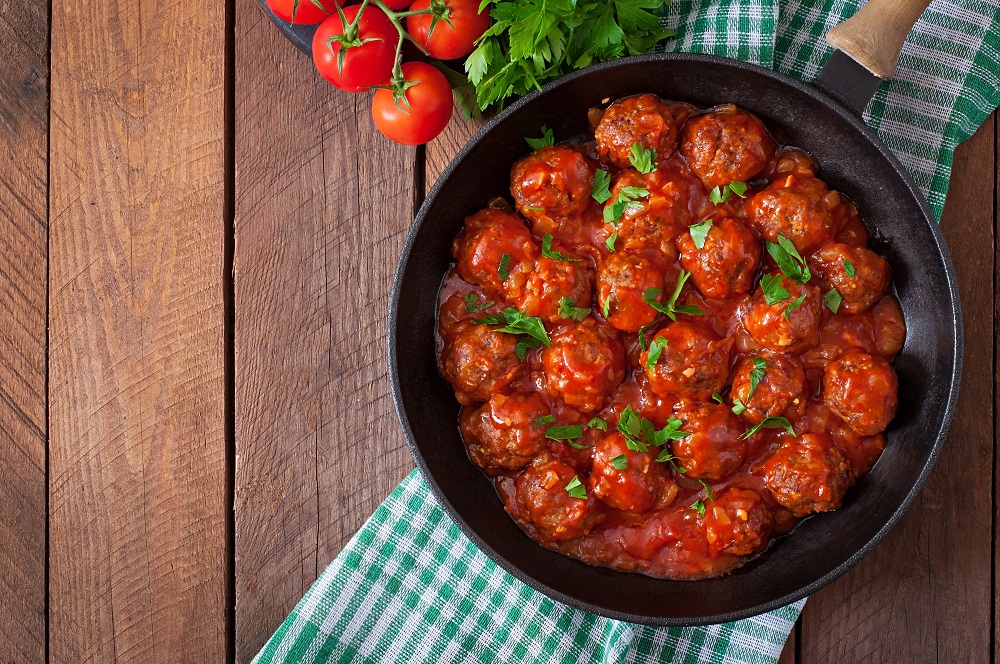Know that even when you are in the kitchen, our Lord moves amidst the pots and pans.
— St Teresa of Avila
Ciao bello and bellas! I don’t know about you, but something that helps me take my mind off of all the many troubles in this world is cooking, and in particular cooking my favorite Italian recipes. So in honor of National Meatball Day, I thought I would share not only my popular meatball recipe, but also some interesting history about meatballs that may surprise you. With winter winding down, but cold temperatures still with us in many parts of the country, I think this recipe and mini history lesson will help warm your hearts and fill your stomach with something good for body and soul. Enjoy!
Happy National Meatball Day! As the old saying goes, “if I had a penny every time…” In this case, if I had a penny for every time while leading a tour across Italy, someone asked about the best ristorante for spaghetti and meatballs, I would be a wealthy woman indeed.
It is a common question as well as a common assumption, especially for Americans visiting Italy. We grew up in this country with not only our own favorite meatball recipe, but seeing and expecting spaghetti and meatballs on the menu of any decent Italian American dining establishment. No wonder not many are aware that the actual dish of spaghetti and meatballs is an American, or more specifically Italian American, invention.
So today, on this National Meatball Day, this full-blooded Italian American, who has had the blessing and thrill of visiting Italy more than 50 times, will attempt to set the record straight. And that ‘s not all, Fratelli and Sorelle, in addition to giving you the inside scoop on spaghetti and meatballs, unlike Marie Barone of “Everybody Loves Raymond” fame, who begrudgingly finally turned her meatball recipe over to her daughter-in-law, I am freely sharing my recipe in this blog. Before we get to the heart, or the meat of the matter, with my recipe, let’s take a look at the history of the meatball.
 It all begins across the pond in what I lovingly call, the “motherland.” Meatballs have always been a common item served in “the boot.” They’re called polpette. The major difference has to do with they way they are served. They are considered a main dish in Italy, but you won’t find them smothered in a bowl of spaghetti and tomato sauce, unless you’re dining in a tourist trap eatery that is trying to cater to American travelers. Instead, several smaller meatballs, usually the size of golf balls, are served alone. They are normally part of the secondo, or meat portion of the Italian meal. Meatballs or polpette can certainly be made with meat. In Italy, however, they’re also, depending on the region, made with different ingredients such as turkey or fish, and much smaller versions, can be found in soups.
It all begins across the pond in what I lovingly call, the “motherland.” Meatballs have always been a common item served in “the boot.” They’re called polpette. The major difference has to do with they way they are served. They are considered a main dish in Italy, but you won’t find them smothered in a bowl of spaghetti and tomato sauce, unless you’re dining in a tourist trap eatery that is trying to cater to American travelers. Instead, several smaller meatballs, usually the size of golf balls, are served alone. They are normally part of the secondo, or meat portion of the Italian meal. Meatballs or polpette can certainly be made with meat. In Italy, however, they’re also, depending on the region, made with different ingredients such as turkey or fish, and much smaller versions, can be found in soups.
In the late 1800’s, through the early part of the 19th century millions of Italians emigrated from the poorest areas of their nation, especially the southern regions including Campania, Calabria, Sicily, and Abruzzi located along the Adriatic coast. As they found work and established their families and neighborhoods, their income grew which allowed them to purchase meat more regularly, something of a rarity for poorer families in Italy. Not only were meat products much more plentiful, so were canned goods, including high quality canned tomatoes. Tomato sauce became a convenient and tasty topping for the meatballs, and since spaghetti was also readily available, the combination became a popular and easy to prepare family meal.
So, there you have it. A short version of the history of spaghetti and meatballs on this National Meatball Day. I could write another entire blog, or several blogs, on the multitude of my family recipes. My mother’s father, Pasquale Tomeo, liked his meatballs sans the sauce, either fried or baked and served as a side to the pasta. He would always have my grandmother reserve a few for him before she placed the rest of the meatballs in the humungous pan of sauce simmering on the stove in their Jersey City flat.
So here is my recipe that I have developed through years of watching my grandmothers, aunts, as well as my Italian American in-laws, make countless batches of meatballs. Enjoy! Or as we say in the motherland, “mangiare”, eat!
Teresa Tomeo’s Meatball Recipe
For the most flavorful meatballs, I find using a combination of beef, veal, and pork, makes all the difference, as well as stale bread as opposed to only dry Italian breadcrumbs. Spices may be adjusted according to taste. You can use an ice cream scoop to keep the size consistent, but I normally just use my hands to form into one-to-two-inch size meatballs. I do not add salt because the grated cheese takes care of the salt component.
- 1 pound of ground round.
- ½ pound ground pork.
- ½ pound ground veal.
- ½ yellow onion, diced into small pieces and sauteed in olive oil until tender.
- 2 eggs
- ¼ to ½ cup grated Locatelli cheese.
- Clove of crushed garlic or 1/4 tsp garlic powder.
- Dried parsley, basil, oregano, to taste. (I usually eyeball these ingredients using a few good shakes of each, but again this can be adjusted according to taste. Normally two to three teaspoons overall of an Italian dried herb mixture will suffice.)
- Splash of milk or cream.
- Italian breadcrumbs or several slices of stale Italian bread moistened with milk. (The amount of dry ingredients depends on how you like your meatballs. If using breadcrumbs, start with a cup and test the consistency. They need to be firm enough to form into balls.)
Add ingredients in a large bowl. Use your hands to combine until ingredients are mixed. Form into balls. Cooking preparation depends on taste. Here are a few suggestions:
- If making with tomato sauce, I usually spray a large saucepan, throw in a bit of olive oil and brown them in the bottom of the pan. I remove after slightly browned and then begin to add my ingredients for tomato sauce. The brown bits of meatball will add incredible flavor. I then add the meatballs back into the sauce to continue the cooking process. I drain most of the grease, however, before beginning the tomato sauce.
- You can also place them on a baking sheet, sprayed with olive oil cooking spray, and bake at 350 degrees for 15 to 20 minutes until cooked through.
- Meatballs may also be fried in batches in a large slightly greased frying pan.
Meatballs can be frozen to add to sauce later. Or try them truly Italian style, serving them on their own as a main dish with a marinara sauce. If you want to take the “when in Rome” approach, eat them as a main course without a sauce, served with a vegetable or green salad on the side.

